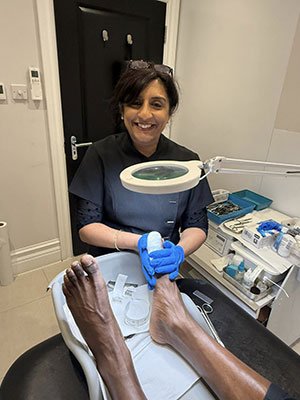Is Your Painful Ingrown Toenail Affecting Your Everyday Life?

If you have tried to treat your ingrown nail without success or taken antibiotics that have not resolved the problem, then you are in the right place. Our experienced and skilled podiatrists/chiropodists at Essex Footcare can help relieve you of pain and cure the problem.
What Is an Ingrown Toenail?
You have an ingrown nail if you have a nail that is pushing into the surrounding soft flesh and the skin around the nail is sore, red, swollen, infected, and acutely painful on pressure. Even the weight of bed clothes can be unbearable.
There are different types of ingrown nails and different reasons for having an ingrown nail, so it is important to have it assessed by an expert, so you don’t have to keep going through the cycle of being prescribed several courses of antibiotics or having to try to cut the nail yourself to solve the problem.
At Essex Footcare our trusted, highly experienced and skilled podiatrists can diagnose what type you have so that we can then create a treatment plan from start to finish.
Types of Ingrown Nails
An ingrown toenail (onychocryptosis) happens when part of the nail pierces the skin creating a swelling, pain and sometimes infection.
An involuted nail is an excessively curved nail, often caused by footwear, injury, fungal infection, or genetics.
An impacted nail may occur when a sharp edge or “spike” of nail grows into the skin after poor nail cutting, trauma, or pressure.
All these conditions can cause inflammation, infection, and discomfort — but with the right podiatric care, most can be treated conservatively and pain relief achieved quickly.

Why Early Treatment Matters
Left untreated the nail continues to grow further into the skin. making the problem much worse over time and infection can result. Early intervention can lead to quicker resolution so you become pain free.
- No GP referral needed — you can see us directly.
- We treat all ages
- Even if it is infected, we can in most cases start treatment immediately; you do not need to have a course of antibiotics before commencing treatment with us.
- Treatment usually begins at the first appointment.
- We create a personalised management plan.
- We take time to explain options clearly, so you feel calm, informed, and in control.
- You do not necessarily need to have nail surgery even if you have been told that you do — or if it has not resolved despite treatment elsewhere or several courses of antibiotics. The correct diagnosis, management plan and treatment pathway is important before nail surgery is considered.
- We are experienced in treating high risk patients – diabetics and people on steroids, anticoagulants, immunosuppressants and chemotherapy as they can be more prone to ingrown nails and infection so early intervention is recommended
Our Approach
At Essex Footcare, your first appointment includes:
- A thorough history, foot assessment and diagnosis of the type of ingrown nail you have
- Topical anaesthetic spray and nail softening used for comfort if required
- Local anaesthetic injection available where necessary
- Gentle removal of the section or spike of nail causing the problem
- Calm, reassuring care throughout so you feel safe, in control and confident
Following treatment:
- Wound care and softening products may be advised and available on-site
- Follow-up aftercare is included to monitor healing and reduce recurrence risk
Expert Treatment Options We Provide
- Conservative care: Removal of the section or spike of nail that is the root cause of pain and infection, nail fold relief, infection support
- For recurrent and stubborn ingrown nails that do not respond to a course of conservative treatment may require nail surgery. This is a planned procedure and involves partial or total nail removal under local anaesthetic with cauterisation of the nail bed so that nail does not regrow. This is not always necessary, and we will always discuss this pathway with you should it be necessary.
- Biomechanical advice & footwear guidance where pressure is a contributing factor.
- Aftercare support so healing is smooth
Why Patients Choose Us
- Highly experienced podiatrists with specialist training
- Calm, sensitive approach for anxious or first-time patients
Trusted by Patients Across Essex
Very friendly place! After going back and forth to the doctors for over a month, Anita sorted out my toe so quickly. Would recommend for anyone who isn’t sure where to go for an ingrown nail :)
 Romford Podiatry
Romford Podiatry





Took my daughter here for an ingrown nail, the lady we saw was so lovely she explained everything she was going to do to my daughter so she knew what was happening. It was nice and quick and the clinic was very clean and the lady on reception was also lovely
 Basildon Podiatry
Basildon Podiatry





I was in pain, they found me a cancelled next day slot, podiatrist was very knowledgeable, gave me lots of advice, made me a device to separate toes, found 2 corns that my nail cutter missed plus a slight ingrown nail which she removed. Brilliant service!
 Billericay Podiatry
Billericay Podiatry






